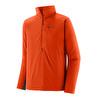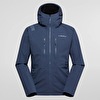Nives Meroi, Romano Benet and the South Face of Annapurna
After failing to even reach Kangchenjunga and being forced therefore to change plans, Nives Meroi and Romano Benet are currently attempting the South Face of Annapurna in orderto climb their 12th 8000m peak. Prevailing conditions on the mountain continue to be difficult and our man in the field Manuel Lugli spoke directly to Romano Benet to find out about the current situation.

 1 / 3
1 / 3
The immense south face of Annapurna, at 8091m, the 10th highest mountain in the world.
 Loris Marin
Loris Marin
Nives Meroi and Romano Benet departed in their usual style, discreetly. Only the objective had been declared: Kangchenjunga. At Kathmandu they were greeted with chaos and a drawn-out protest in SE Neapl which created serious problems to the expedition logistics. But Nives Meroi and Romano Benet, with their hallmark calm and decisiveness, managed to take the blow and chose to head to the South Face of Annapurna. Which isn't quite the same as saying: OK, Monte Rosa can't be climbed, who cares, let's do the Vincent Pyramid.
Some of the strongest mountaineers in history have given the South Face of Annapurna a shot. To name but a few: Chris Bonnington, leader in 1970 of the legendary expedition which succeeded in summiting aces such as Don Whillans, Doug Haston and Ian Clough, who subsequently died during the descent; Soro Dorotei, Benoit Chamoux, Stephen Boyer, Josef Rakoncaj and Nicolas Campredon, protagonists of the 1988 expedition which repeated the British route; Jean Christophe Lafaille who on this face lived through an incredible odyssey after the fall of his partner Pierre Beghin; Tomasz Humar who achieved an impressive solo ascent - even if this did not conclude with the main summit. Put in other words, a face which is demanding like few others, vertical and extremely technical.
After having twice attempted the normal route up the N Face and after having twice risked their lives due to serac fall and avalanches on this dangerous face, Nives and Romano had decided that they would return to the South Face. More difficult, certainly, technical with some vertical sections at the highest of altitude, but undoubtedly with fewer objective dangers. Said and done. The mountaineers from the Friuli inverted their course and instead of flying east to "The Five Treasures of Snows", which is what the name Kanchenjunga means, they headed west to "The Goddess of Plenty", the fearsome Annapurna, which has never relinquished its fame. In fact, since their arrival at Base Camp on 31 March, it has done nothing else but snow. This has obvioulsy seriously hampered progress, so much so that from Base Camp they haven't even been given the opportunity of glancing at the Face to see if it's in condition.
After some days spent waiting, Romano and Nives finally managed to make some headway upwards only to discover that the great serac fields which provide access to the base of the wall are extremely complicated and difficult. Seeing that the main objective had been Kanchenjunga, this section hadn't been studied in great detail. This is further complicated for those who, like them, climb in complete autonomy, without high altitude Sherpas to transport gear to the upper camps. After some quick calls over the last couple of days to resolve a technical problem related to the sat phone data transmission, yesterday morning we finally managed to chat to Romano. He is currently sitting out a storm with Nives at Base Camp which has resulted in another 50cm of fresh snow.
"Yes, it's been snowing for a while" Roman told us "it should continue until tomorrow or the day after, then stop. We'll see. We climbed up to circa 5600m the other day, but this part of the glacier is terrible, worse than the Everest Icefall: seracs, crevasses, huge vertical steps. A labyrinth where it's difficult to find the right way through. Everyone talks about the difficulties of the South Face, but at present the real problem is down here: climbing out of the serac field onto the plateau and reaching the face proper. And with all the gear in out rucksacks we're having to work extremely hard."
"And the other mountaineers, have you seen them?" we ask. "Two from the Czech republic, and Dodo Kopold, and a French woman who attempted the serac field but returned to base camp. They then went to the Bonnington route, but retreated from there, too. The others in the team are climbing up and down Tent Peak (easy peak in the vicinity, Editor's note), perhaps to acclimatise. Who knows... We can't really understand what they're up to. We're stting out the storm and then we'll search for a way through the serac field, hoping not to have to commute there and back too often. Also because it's really tiring and the temperatures range from baking hot to freezing cold in a matter of minutes, with the risk of frostbite which at this altitude wouldn't get better. But for the time being we're fine."
"Good, stay strong, and a big Namastè" we say with ease, as we imagine the two of them at the foot of this immense, kilometer wide wall. Two "small" mountaineers, in their tents, assisted by two "small" Nepalese cooks, alone with their great experience and determination and the knowledge that they are facing the Goddess of Plenty, not just any old rock face. Nives and Romano, who have seen many a mountain, know that however things turn out, the "Laghyelo" holds true, the Gods always win.
Manuel Lugli
Some of the strongest mountaineers in history have given the South Face of Annapurna a shot. To name but a few: Chris Bonnington, leader in 1970 of the legendary expedition which succeeded in summiting aces such as Don Whillans, Doug Haston and Ian Clough, who subsequently died during the descent; Soro Dorotei, Benoit Chamoux, Stephen Boyer, Josef Rakoncaj and Nicolas Campredon, protagonists of the 1988 expedition which repeated the British route; Jean Christophe Lafaille who on this face lived through an incredible odyssey after the fall of his partner Pierre Beghin; Tomasz Humar who achieved an impressive solo ascent - even if this did not conclude with the main summit. Put in other words, a face which is demanding like few others, vertical and extremely technical.
After having twice attempted the normal route up the N Face and after having twice risked their lives due to serac fall and avalanches on this dangerous face, Nives and Romano had decided that they would return to the South Face. More difficult, certainly, technical with some vertical sections at the highest of altitude, but undoubtedly with fewer objective dangers. Said and done. The mountaineers from the Friuli inverted their course and instead of flying east to "The Five Treasures of Snows", which is what the name Kanchenjunga means, they headed west to "The Goddess of Plenty", the fearsome Annapurna, which has never relinquished its fame. In fact, since their arrival at Base Camp on 31 March, it has done nothing else but snow. This has obvioulsy seriously hampered progress, so much so that from Base Camp they haven't even been given the opportunity of glancing at the Face to see if it's in condition.
After some days spent waiting, Romano and Nives finally managed to make some headway upwards only to discover that the great serac fields which provide access to the base of the wall are extremely complicated and difficult. Seeing that the main objective had been Kanchenjunga, this section hadn't been studied in great detail. This is further complicated for those who, like them, climb in complete autonomy, without high altitude Sherpas to transport gear to the upper camps. After some quick calls over the last couple of days to resolve a technical problem related to the sat phone data transmission, yesterday morning we finally managed to chat to Romano. He is currently sitting out a storm with Nives at Base Camp which has resulted in another 50cm of fresh snow.
"Yes, it's been snowing for a while" Roman told us "it should continue until tomorrow or the day after, then stop. We'll see. We climbed up to circa 5600m the other day, but this part of the glacier is terrible, worse than the Everest Icefall: seracs, crevasses, huge vertical steps. A labyrinth where it's difficult to find the right way through. Everyone talks about the difficulties of the South Face, but at present the real problem is down here: climbing out of the serac field onto the plateau and reaching the face proper. And with all the gear in out rucksacks we're having to work extremely hard."
"And the other mountaineers, have you seen them?" we ask. "Two from the Czech republic, and Dodo Kopold, and a French woman who attempted the serac field but returned to base camp. They then went to the Bonnington route, but retreated from there, too. The others in the team are climbing up and down Tent Peak (easy peak in the vicinity, Editor's note), perhaps to acclimatise. Who knows... We can't really understand what they're up to. We're stting out the storm and then we'll search for a way through the serac field, hoping not to have to commute there and back too often. Also because it's really tiring and the temperatures range from baking hot to freezing cold in a matter of minutes, with the risk of frostbite which at this altitude wouldn't get better. But for the time being we're fine."
"Good, stay strong, and a big Namastè" we say with ease, as we imagine the two of them at the foot of this immense, kilometer wide wall. Two "small" mountaineers, in their tents, assisted by two "small" Nepalese cooks, alone with their great experience and determination and the knowledge that they are facing the Goddess of Plenty, not just any old rock face. Nives and Romano, who have seen many a mountain, know that however things turn out, the "Laghyelo" holds true, the Gods always win.
Manuel Lugli
Note: All 8000m peaks (without supplementary oxygen) climbed by Nives Meroi and Romano Benet:
Manaslu (2008)
Everest (2007)
Dhaulagiri (2006)
K2 (2006)
Lhotse (2004)
Gasherbrum 1 (2003)
Gasherbrum 2 (2003)
Broad Peak (2003)
Cho Oyu (2003)
Shisha Pangma (1999)
Nanga Parbat (1998)
Still to be climbed:
Kangchenjunga, Annapurna, Makalu.
Manaslu (2008)
Everest (2007)
Dhaulagiri (2006)
K2 (2006)
Lhotse (2004)
Gasherbrum 1 (2003)
Gasherbrum 2 (2003)
Broad Peak (2003)
Cho Oyu (2003)
Shisha Pangma (1999)
Nanga Parbat (1998)
Still to be climbed:
Kangchenjunga, Annapurna, Makalu.
| News Meroi - Benet | |
| nives.alpinizem.net | |
| Società Italiana Medicina di Montagna | |
| Expo Grivel | |
| www.montura.it |
Latest news
Expo / News
Expo / Products
Merino Wool Ski Mountaineering Sock.
A versatile high performance three season layering piece perfect for the summer months.
Technical footwear for high altitude mountaineering and ice climbing.
The Guida HDry gloves are the evolution of the Guida model, enhanced with HDry technology, making them ideal for all weather conditions.
Hardshell jacket for technical mountaineering and climbing.
Kunene Jacket Woman is an ultra light jacket that takes up a minimum of space.



 Copia link
Copia link























